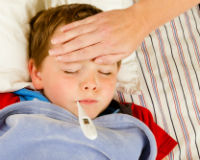Causes of and Treatment for Sore Throat in Children
It seems like children always get a sore throat once or twice a year. What should you do when this happens? Could it be strep throat? How can you tell? Should you go to the doctor? Should you just call your doctor and ask for medicine over the phone? Here is the Dr. Sears guide to diagnosing and treating a sore throat in children.
Causes of Sore Throat
Some of the common causes of sore throat in children are:
Viruses
By far, the most common cause of sore throat in children is any one of a large number of viruses, none of which are treatable with antibiotics. These viruses can cause high fever and very painful sore throat. They can feel just as bad or worse as strep throat.

Sore Throat and Coughs
The common cold virus can cause a sore throat in addition to its many other symptoms. Coughing can also irritate the throat, and so can post-nasal drip from a cold.
Strep Throat
This is caused by the strep bacteria, and is treated with antibiotics. (See more on Strep below.)
Coxsackie Virus (Hand, Foot and Mouth Disease)
This is a virus that causes high fever and painful canker sores on the throat, cheeks, gums or lips. Click on mouth sores for more info on this.
Allergies
Allergies do not cause sudden sore, painful throats. They can, however, cause chronic mild throat irritation.
Does My Child Have Strep Throat?
The main question parents should ask when their child has a sore throat is “does my child have strep that needs antibiotics or is this just a virus?” The answer to this is not always obvious. Here are some clues to help you decide:
- Fever is very common to strep throat; although viruses can also give you fever. Fever over 101 for more than three days is more likely to be strep throat.
- Very red throat with bright red spots on the back of the palate and white pus on the tonsils. One note, however, is that some viruses can also look this way, and sometimes strep may not look this bad.
- Known exposure to someone with strep throat.
- It’s uncommon for a child less than age 3 to get strep throat.
- Swollen neck glands.
- Strep throat is most common during late fall and winter.
- Pain during swallowing or pressing on the neck glands or having pain during coughing usually is not strep throat.
- No other symptoms besides sore throat and fever – strep throat usually does not cause multiple symptoms such as runny nose, cough and congestion. If you have multiple symptoms, it is less likely to be strep.
- Headache, stomachache and vomiting can, however, occur with strep.
- There is a characteristic rash that sometimes accompanies strep throat. This appears as fine, red pimples all over the trunk (chest, abdomen and back) that feel rough, almost like sandpaper and may look like a sunburn. This rash, with strep throat, is called Scarlet Fever. Do not worry; this is not serious like it used to be. It is simply the body reacting to a toxin produced by the strep. It does not mean the infection is more serious than strep throat without a rash, and it goes away with treatment.
Signs that Your Child is more Likely to have an Untreatable Virus, and not Strep:
- Age 3 or younger
- Multiple cold or flu symptoms
- Throat not very red
- Child not acting very sick overall
- Throat pain only when coughing, but not when swallowing or pressing on throat
How Did My Child Catch Sore Throat?
All throat infections are transmitted via the saliva, either from coughing or contact with the bacteria or virus on an infected person’s hands or personal items. The incubation period (the time from when you contact the illness to the time when you feel sick) is 2 to 5 days. The incubation period for viral causes of sore throat in children varies from 3 days to 2 weeks.
When Should I go to the Doctor?
Do not run your child to the doctor at the first sign of a sore throat. Wait a day or two, or more if your child is not acting ill. See which direction the illness is going. If your child begins to fit the picture of strep throat above, then see your doctor.
Treating Sore Throat in Children
At-home treatments:
- Pain reliever. Acetaminophen or Ibuprofen can help significantly. Click on them for dosing. Use both together for extreme pain.
- Throat lozenges.
- Gargle warm salt water. Mix 1/4 to 1 Tsp salt with 8 ounces warm water. If you can get your child to do this, it works great!
- Anesthetic throat gargle. Chloraseptic can work well, but only if your child is old enough to not swallow it.
- Tea. Some herbal teas with honey or lemon may help.
Dr. Sears Clue: Citrus juices, such as orange juice, often “burn” the sore throat caused by a virus but are usually not painful to strep throat.
Antibiotics:
- Penicillin. This is the usual treatment for strep throat. It has several drawbacks however: it must be taken three times a day, and the liquid for children tastes terrible.
- Amoxicillin. This is the “pink stuff”, and is probably the most commonly used antibiotic for strep throat. The liquid tastes much better for children, and is only given twice a day. Even if this antibiotic has not worked well for your child for past ear and sinus infections, it is still effective for strep throat. It is important you take the antibiotics for a whole 10 days, or else the strep might come back. Some research has shown a shorter course of antibiotics may work, but this has not yet become standard.
- Penicillin shot. If the thought of trying to get your child to take an antibiotic twice daily for 10 days sounds like too much of a chore, this option might be for you. A one-time shot in the muscle of Long Acting Bicillin, although initially painful, is a convenient way to make sure your child gets treated for the strep throat.
Diagnosing Strep Throat
When you take your child to the doctor, he or she will examine your child’s throat and neck glands. If the child fits all the signs of strep, and the throat looks exactly like strep, then your doctor may elect to assume it really is strep and treat with an antibiotic without doing a throat swab test to check for strep. If it looks nothing like strep, and your child is acting fine, your doctor may choose not even to do a test and consider the infection viral. This is a common approach.
Another common approach is to rely on a throat swab test to help decide whether or not strep is present. A cotton swab is rubbed against the back of the throat and the tonsils. It can make most children gag. There are two types of throat swab tests:
Rapid Strep Test
This test can be run in your doctor’s office, and takes just five minutes. It is about 95% accurate, which means that it will miss about 5% of strep throats. It is therefore very useful if it shows positive – you know for sure your child has strep throat. However, if it shows negative (not strep), then you can only be 95% sure that your child really doesn’t have strep throat.
Throat Culture
This test usually would be run in a lab, using a throat swab collected in the doctor’s office. Very few doctor’s offices run this test themselves. The lab will place the throat swab in an incubator to see if the strep bacteria grow. This test is about 99% accurate, and therefore less likely to miss strep throat. One drawback is that it takes 24 to 48 hours for the lab to grow strep.
Some doctors will rely on only one of these tests. Other doctors will first run a rapid test, and if it does not show strep, send a throat culture to be sure your child does not have strep. The decision of which test to do, and when to do it, is based on what the throat looks like and how sick the child is.
There is a trend toward increased use of throat swabs to confirm strep before treating. This is to decrease the unnecessary use of antibiotics and avoid antibiotic resistance.
If a throat culture is sent, what do you do for the next 48 hours while waiting for the results? If your child is fairly sick, with fevers and very sore throat, the doctor may elect to start an antibiotic right away. If the culture comes back negative (not strep), then your doctor may advise you to stop the antibiotics. If your child is not very sick, then your doctor may choose to wait the 1 or 2 days without antibiotics pending the results of the strep culture.
Concerns
“I am worried that if my child has strep throat he should start antibiotics right away. I don’t want him to get sicker while waiting to go in to see the doctor or waiting for a culture result.”
This is an obvious concern for parents, and is a big reason many parents want to start an antibiotic over the phone on the weekend for a bad sore throat in children.
The truth about strep is that it is safe to wait a couple of days before treatment is started. Studies have shown that delaying treatment does not increase the risk of complications from strep. One study has even shown a beneficial effect if treatment is delayed because the body has a few days to mount an immune response to the infection. The only drawback from delayed treatment is more days of sore throat. If possible we recommend treating strep throat early rather than later.
How Long is a Sore Throat in Children Contagious?
For strep throat treated with antibiotics, your child is no longer contagious after 24 hours of antibiotics (it used to be 48 hours, but was recently changed to 24 hours). For viral sore throat, your child is no longer contagious once he has been fever free for 24 to 48 hours (without any medication to hide the fever).
Prevent Spreading
“If my child has strep throat, what can I do to prevent it from spreading to family and friends and from re-occurring?””
Here are some basic instructions to keep the infection contained:
- Throw away your child’s toothbrush. Use a new toothbrush for two days once antibiotics are started, then throw that one away. You can then stick with a new one after that.
- Clean any dental appliances (retainers, etc.) well every day for the first few days on antibiotics.
- Any family members or friends who have come in contact with a person with strep throat do not have to be automatically tested for the illness unless they themselves become ill. If a family member becomes ill with obvious symptoms of strep throat, then your doctor may elect to treat that person without testing.
Complications of Strep Throat
The complications from strep throat could include:
Rheumatic Fever
Occurs when the body’s immune system interacts in an abnormal way with the strep bacteria. This interaction is not well understood, but is thought that the bacteria combine with antibodies. These combined clusters attack the heart valves, joints, skin and other organs. While this is an extremely rare complication, you should see your doctor right away or go to an ER if your child gets severe chest pain, shortness of breath, joint aches and inflammation and red, blood colored spots on the skin. This usually does not occur until several weeks after a strep infection.
Glomerulonephritis
This complicated word simply means inflammation of the kidneys. Through a similar mechanism as rheumatic fever, the bacteria/antibody clusters lodge in the kidneys, causing bleeding into the urine and decreased kidney function. This also does not usually occur for several weeks after a strep infection. You should call your doctor if you see any blood in the urine, dark cola-colored urine, a sharp decrease in urine volume, and swelling of the face, ankles and feet.
These two complications are very, very rare. Treating strep throat with an antibiotic will virtually eliminate the risk of rheumatic fever. Glomerulonephritis, on the other hand, is not prevented by antibiotics. It just occurs randomly, but again, very, very rarely.



